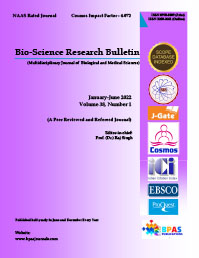Plant and Animal Cell Systems in Cancer Biology
DOI:
https://doi.org/10.48165/Keywords:
Tea, Fruits, Cocoa, Polyphenols, Caffeic acid, Tumeric, Naturally-derived compounds, G2 / MAbstract
Cancer biology is a broad area of study, and a lot of emphasis has been placed on drug design. The development of functional drug compounds relies on the outcome of cell responsive studies that involve animal cells, the cancer, as well as, compounds from plants. The variability in the response of cancer to plant compounds is important in order to understand the mechanisms involved in cancer metastasis and progression in animal hosts. This theme will form the basis of this contribution.
References
Singh, R., Reddy, L. (2012). Molecular immunogenetics of apoptosis: Experimental dilemmas. International Journal of Biological and Pharmaceutical Research 3 (4), 550 - 559.
Singh, R. (2014). International and cytotoxity of compounds with human cell lines. Romanian Journal of Biochemistry 51 (1), 57 - 74.
Singh, R. (2016). Conclusivity of cytotoxicity and drug susceptibility tests. Bio-Science Research Bulletin 32 (1/2), 17 - 20.
Singh, R. (2020). A medical briefing on the p-53 tumour suppressor gene. Bio-Science Research Bulletin 36 (2), 101 - 102.
Singh, R. (2017). Three biological characteristics that's required for sustaining the livelihood of prokaryote and eukaryote cells. Brazialian Journal of Biological Sciences 4 (8), 223-231.
Wu, J., Karision, K., Danielsson A. (1997).
Effects of vitamin E, ascorbic acid and catalase in bromobeneze- and hydrogen peroxide-induced intracellular oxidation and single strand DNA breakage in HEp-G2 cells. Journal of Hepatology 26, 669-677.
Hoaren, L., DaSilva, EJ. (1999). Medicinal Plants: a re-emerging health aid. EJB Electronic Journal of Biotechnology 2(2), 56 - 70.
Murray, AW. (1993). Cell-cycle control: turning on mitosis. Current Biology 3, 291 - 293.
Lee, JY, Hwang, WI., Lima, ST. (2004). Antioxidant and anticancer activities of organic extracts from Platycodon grandiflorum A. De Candolle roots. Journal of Ethnopharmacology 93, 409-415.
Fukuda, M., Ohzoshi, E., Makino, M., Fugimoto, Y. (2006). Studies on the constituents of the leaves of Braccharis druncunculifolia (Asteraceae) and their cytotoxicity activity. Chemistry and Pharmaceutical Bulletin 54, 1465-1468.
Bufalo, ML., Candelias, JMG., Sousa JPB, Bastos, JK., Sforein, JM. (2010). In vitro cytoxicity activity of Braccharis druncunculifolia and propolis against HEp-2 cell. Natural Product Research 24 (18), 1710 - 1718.
Calvert, TW., Aidoo, KE., Candlish, AGG., Mohd Fant, AR. (2005). Comparison of in vitro cytotoxicity of Fusarium mycotoxins, deoxynivalenol, T-2 toxin and zearalenone on selected human epithelial cell lines. Mycopathologia 159, 413 - 419.
Gu, L., Kelin, MA., Hammerstori JF., Becher, G., Holden,T., Haytowit, D., Gebhardt, S., Prior, RL. (2003). Screening of foods containing proantrocyanidine and then structural characteristics using LC-MS/MS and thiolytic degradation. Journal of Agricultural and Food Chemistry 51: 7513 - 7521.
Singh, R. (2018). Major concerns with the cryostorage of mammalian cell cultures. Bio-Sciences Research Bulletin 34 (2), 72 - 75.
